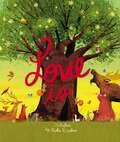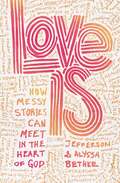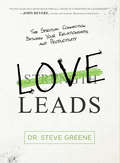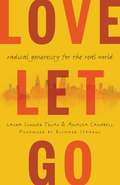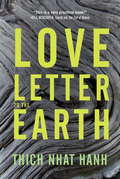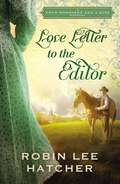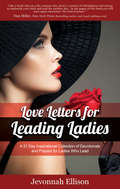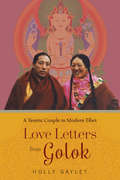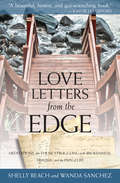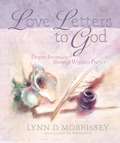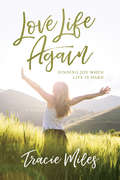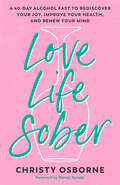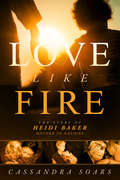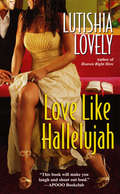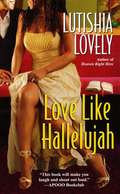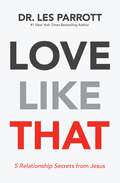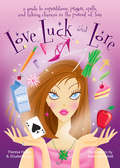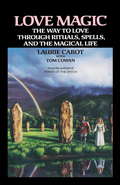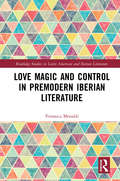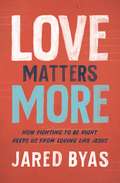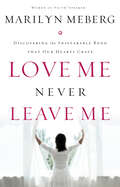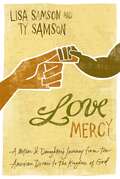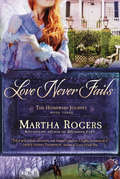- Table View
- List View
Love Is: An Illustrated Exploration of God’s Greatest Gift (Based on 1 Corinthians 13:4-8)
by Zondervan&“Love is patient, love is kind.&” These familiar words from the Bible begin one of its most beloved and recognized passages. Love Is brings the text of 1 Corinthians 13 to life through an illustrative exploration of God&’s greatest gift to us.Critically acclaimed artist Paola Escobar delivers beautiful, nature-filled illustrations , reminding us that love is a constant positive force in the lives of those touched by it–from beginning to end, through good times and tough times.This beautiful, jacketed hardcover:Will appeal to parents and grandparents of children ages 4-8Draws directly from the New International Reader&’s Version of the Holy BibleFeatures stunning illustrations by award-winning artist Paola EscobarIs perfect for gift-giving for Christmas, Valentine&’s Day and birthdaysIs especially giftable for anniversaries, engagements or weddingsLove Is shares imaginative, thought-provoking depictions of the concepts found in 1 Corinthians 13, presenting opportunities for thoughtful conversations about love, selflessness, service, humility, honor, self control, trust, hope and perseverance. Read this picture book aloud to someone you love ... over and over again.
Love Is: How Messy Stories Can Meet in the Heart of God
by Jefferson Bethke Alyssa BethkeRetitled, repackaged, and including new content, Love Is delivers a compelling message that urges Christians to reject the distorted views of love that have damaged our hearts, minds, and souls and to embrace God&’s biblical definition of what love truly is.So many young people enter adulthood with expectations of blissful dating followed by a romantic marriage but then discover they&’ve been duped. Because they learned about love and sexuality from faulty sources—social media, their friends, Disney fairy tales, pornography, or even their own rocky past—they have no idea what healthy, lifelong love is supposed to be like. The results are often disastrous, with this generation becoming one of the most relationally sick, sexually addicted, and divorce ridden in history.Looking to God&’s design while drawing lessons from their own successes and failures, the Bethkes explode the fictions and falsehoods that have led to broken relationships. One by one, they peel back lies that include:the belief that every person has only one soul mate,that marriage will complete you,and that pornography and hook-ups are harmless.Drawing from Jeff&’s &“prodigal son&” personal history and from Alyssa&’s &“True Love Waits&” experience, the Bethkes blend personal storytelling with biblical teaching to offer readers an inspiring, realistic vision of love, dating, marriage, and sex. Including a new chapter filling readers in on the Bethke&’s married relationship today, this updated edition offers a solidly biblical view of romantic love.
Love Leads: The Spiritual Connection Between Your Relationships and Productivity
by Dr. Steve GreeneThis book will help you see that love and leadership are not mutually exclusive and learn that without love, you cannot be an effective leader. The one action verb most frequently missing from various manifestos on leadership is love. In Love Leads Dr. Steve Greene shares real-life examples, principles, and exhortations of the love of a leader. You will discover what it looks like to lead with love—is there a process of love? is tough love really love?—and you will view leadership as it&’s never been seen before as Dr. Greene dispels the myths and misconceptions many have come to accept about leadership. The real-life principles in this book are fully supported throughout by the actions of God who &“so loved that He gave…,&” leading you to see with new insight that the true essence of leadership is love.
Love Let Go: Radical Generosity for the Real World
by Laura Truax Amalya CampbellDisplays the amazing power of generosity to transform people and communities When LaSalle Street Church in Chicago received an unexpected windfall, its leaders made the wild, counterintuitive decision to give it away. Each church member received a check for $500 with the instruction to go out and do good in God's world. In Love Let Go readers witness how a church community was transformed by the startling truth that money can buy happiness—when we give it away. Laura Sumner Truax and Amalya Campbell show how this radical generosity shaped their community, exploring the reverberating impact of each act of generosity, and ultimately revealing how LaSalle's faith-filled risk snowballed into a movement beyond itself. Throughout the book Truax and Campbell probe the connection of human flourishing to generosity and offer tools to help us reclaim our giver identities and live generously—to love and let go.
Love Letter to the Earth
by Thich Nhat HanhWhile many experts point to the enormous complexity in addressing issues ranging from the destruction of ecosystems to the loss of millions of species, Thich Nhat Hanh identifies one key issue as having the potential to create a tipping point.<P> He believes that we need to move beyond the concept of the "environment," as it leads people to experience themselves and Earth as two separate entities and to see the planet only in terms of what it can do for them. Thich Nhat Hanh points to the lack of meaning and connection in peoples' lives as being the cause of our addiction to consumerism. He deems it vital that we recognize and respond to the stress we are putting on the Earth if civilization is to survive. Rejecting the conventional economic approach, Nhat Hanh shows that mindfulness and a spiritual revolution are needed to protect nature and limit climate change. Love Letter to the Earth is a hopeful book that gives us a path to follow by showing that change is possible only with the recognition that people and the planet are ultimately one and the same.
Love Letter to the Editor
by Robin Lee HatcherIt's 1885 and five preachers sit around a campfire out West, trading stories of unlikely couples they've seen God bring together. This is one of those stories . . .She's the best writer the paper has ever had. He's her new editor. And she doesn't like it one bit.Molly Everton is the outspoken daughter of the town's newspaper publisher. She had the best education her father's money could buy and she's a better writer than he is. So when her father passes her over for the position of editor and gives the job to an outsider from back East, she's furious. But a smart girl like Molly knows she can drive the new guy out of town with little trouble if she plays her cards right . . .Jack Ludlow came out West for adventure and wide open spaces, not romance. And he's not intimidated by the beautiful daughter of his new employer. At first he's just trying to prove to her he is the right man for the job--but before long he's set on stealing her heart."Robin's stories are always an adventure of the heart!She is one of the premier storytellers of our day." --Karen Kingsbury, best-selling author
Love Letters for Leading Ladies: A 31 Day Inspirational Collection of Devotionals and Prayers for Ladies Who Lead
by Jevonnah EllisonHave you ever wished you had someone who “got you”, who truly understands when you feel alone and in a place of transition? Or someone who is not judgmental, who understands what it is like to be a Leading Lady because she is a Leading Lady herself? Jevonnah Ellison has been there. She wants to help Leading Ladies know they’re not alone. A Leading Lady is any woman in a leadership role - a boss, a Pastor’s wife, an entrepreneur, a President’s wife, a coach, a mom, a friend. She can be married; she can be single. The bottom line is that she is a leader. She is someone to whom others come for her knowledge, wisdom and advice. This Leading Ladies Devotional will help you: Understand why you were chosen for this assignmentUnderstand your divine call Discover secrets and strategies for surviving as a Pastor’s wife! Imagine how powerful it will be when you discover that the same God who was with you “then” is with you “now.”
Love Letters from God: Bible Stories (Love Letters from God)
by Glenys NellistWhat child does not love to receive mail? What if your child could receive and read his or her own personal mail from God? Love Letters from God invites them to do just that! With 18 of the most popular Bible stories, each story is accompanied by a special and encouraging letter. Love Letters from God is the first book in the series written by Glenys Nellist. Unique features include:18 letters from GodGorgeous, bright illustrations by Sophie Allsopp9 stories from the Old Testament and 9 stories from the New TestamentThis picture book is perfect for ages 4–8 and is great for birthdays, Easter baskets, Valentine&’s Day, holiday gift giving, or as an addition to your child&’s digital library.Check out other titles from this series, Love Letters from God: Bible Stories for a Girl&’s Heart, Easter Love Letters from God: Bible Stories, and Christmas Love Letters from God: Bible Stories.
Love Letters from God; Bible Stories for a Girl’s Heart: Bible Stories For A Girl's Heart (Love Letters from God)
by Glenys NellistAre you looking for a way to teach your child about the incredible women in the Bible? This heartwarming picture book will fill girls&’ hearts with the wonder of Lord. With 14 Bible stories about women who made a difference, each story is paired with a heartfelt letter from God in its own envelope and beautiful illustrations. Bible Stories for a Girl&’s Heart is part of the Love Letters from God series written by Glenys Nellist. Unique features include:14 letters from God, enclosed in an envelope your child can open, and personalization space to write your child&’s name on each letterGorgeous bright illustrations by Rachel Clowes7 stories from The Old Testament and 7 stories from The New TestamentThis picture book is perfect for ages 4-8 and is great for birthdays, Easter baskets, Valentine&’s Day, holiday gift giving, or as an addition to your child&’s home library.Check out other titles from this series, Love Letters from God: Bible Stories, Easter Love Letters from God: Bible Stories, and Christmas Love Letters from God: Bible Stories.
Love Letters from Golok: A Tantric Couple in Modern Tibet
by Holly GayleyLove Letters from Golok chronicles the courtship between two Buddhist tantric masters, Tāre Lhamo (1938–2002) and Namtrul Rinpoche (1944–2011), and their passion for reinvigorating Buddhism in eastern Tibet during the post-Mao era. In fifty-six letters exchanged from 1978 to 1980, Tāre Lhamo and Namtrul Rinpoche envisioned a shared destiny to "heal the damage" done to Buddhism during the years leading up to and including the Cultural Revolution. Holly Gayley retrieves the personal and prophetic dimensions of their courtship and its consummation in a twenty-year religious career that informs issues of gender and agency in Buddhism, cultural preservation among Tibetan communities, and alternative histories for minorities in China.The correspondence between Tare Lhamo and Namtrul Rinpoche is the first collection of "love letters" to come to light in Tibetan literature. Blending tantric imagery with poetic and folk song styles, their letters have a fresh vernacular tone comparable to the love songs of the Sixth Dalai Lama, but with an eastern Tibetan flavor. Gayley reads these letters against hagiographic writings about the couple, supplemented by field research, to illuminate representational strategies that serve to narrate cultural trauma in a redemptive key, quite unlike Chinese scar literature or the testimonials of exile Tibetans. With special attention to Tare Lhamo's role as a tantric heroine and her hagiographic fusion with Namtrul Rinpoche, Gayley vividly shows how Buddhist masters have adapted Tibetan literary genres to share private intimacies and address contemporary social concerns.
Love Letters from the Edge: Meditations for Those Struggling with Brokenness, Trauma, and the Pain of Life
by Shelly Beach Wanda SanchezMillions of women in the United States battle with after-effects of suffering so great they've developed post-traumatic stress disorder--the same suffering experienced by soldiers who've gone through war. Sexual and physical abuse, catastrophic accidents, abandonment, natural disasters, invasive medical procedures, and many other painful and overwhelming events can trigger symptoms they are little equipped to deal with and hard-pressed to recognize. Love Letters from the Edge provides a voice for those struggling to express this pain and reveals intimate encouragement for those in desperate need to hear God's words of love and deliverance. This heartfelt devotional focuses on the profound laments in the book of Psalms. Each meditation begins with a letter from someone in the throes of despair and then offers a tender response to their pain from God's perspective. Fresh, honest, and intimate, Love Letters from the Edge will reach readers who never expected to hear good news from where they are and point them toward the hope and healing of Christ.
Love Letters to God: Deeper Intimacy Through Written Prayer
by Lynn D. MorrisseyWomen yearn to share their experiences with the Lover of their souls in a way that is honest and simple, yet deeply satisfying. The key to this intimate self-expression is prayer-journaling. By pouring her heart out on paper to God, a woman can enjoy God's loving presence, explore her purpose and passion, appreciate life's beauty and answer its perplexities, experience spiritual transformation, and leave a permanent record of God's faithfulness in her life. Love Letters to God is a woman's invitation to take a personal pilgrimage through her own 'sacred writings' to the very heart of God. DISCOVER THE WAY TO GOD'S HEART Your holding an invitation in your hands-an invitation to take a personal pilgrimage through your own 'sacred writings' to the very heart of God. If you're intimidated by praying aloud or easily distracted during your devotional time, pouring your heart out on paper will give you the privacy and intimacy you need. Inspired by these beutifully written reflections, you'll find the most fullfilling way to enjoy God's loving presence, explore your purpose and passion, and leave a permanent record of His love and faithfulness in your life. Find freedom, healing, hope, and security as you share your deepest longings with the lover of your soul. Story Behind the Book Writing one's prayers in a journal (unlike verbal or silent prayers) provides an actual safe place to grow spiritually and to enjoy and enhance a personal relationship with God. Verbal prayers are soon forgotten, but our "love letters to God" become a permanent place for exploring our hearts, a tangible testimony of God's love and faithfulness in our lives, and a detailed document of our spiritual journeys. We can literallyseethe progression of changes in our lives as expressed on the "pages of our soul," our prayer journals, and we canseeGod's answers to our prayers recorded there. Like the psalmists, many people have discovered that writing is the key to intimate self-expression, providing a deep, emotional catharsis that is often missing from their verbal or silent prayers.
Love Life Again: Finding Joy When Life Is Hard
by Tracie MilesIn Love Life Again, Tracie reminds readers they each get only one life to live and inspires them not to take it for granted. Through compelling personal stories and powerful insights from Scripture, she helps women identify the stumbling blocks to their joy and offers tools and insights to take back control of their happiness. Every chapter ends with a practical call to action to motivate readers to begin loving their lives again. She also offers reflection questions, prayers, and creative ideas to help readers smile. Love Life Again helps readers learn how to live the abundant lives Jesus died for them to have, despite the circumstances they may face.
Love Life Sober: A 40-Day Alcohol Fast to Rediscover Your Joy, Improve Your Health, and Renew Your Mind
by Christy OsborneA 40-day, alcohol-free journey to reset your drinking habits, reconnect with yourself, and strengthen your relationship with Jesus—from a certified sobriety coach with you-can-do-it positivity &“A masterful, transformative, and grace-filled guide . . . Christy Osborne blends spiritual wisdom with forty days of actionable strategies, empowering you to embrace sobriety with faith and resilience.&”—Jennifer Dukes Lee, author of Growing Slow and It&’s All Under ControlWhat if your best life is a sober life? Double-certified sobriety coach Christy Osborne discovered this in her own life and has helped countless clients realize the same. Now, in this highly practical guide, she brings together the psychology of habits and triggers, truth and hope from Scripture, and the science of alcohol&’s effect on the body for a forty-day alcohol reset. Experience the gifts of sobriety through enhanced sleep, clearer thinking, better health, deeper connections with others, and a restored sense of well-being.Going alcohol-free might sound difficult, but for any hesitations you may have, this companionable guide provides a simple and approachable way for you to explore a new path toward a healthier, more joyful life. With lots of practical encouragement, each short and engaging chapter shows you how to• overcome alcohol cravings in the moment• identify triggers and apply new habits• escape the willpower trap• navigate social events without losing your sense of fun• cultivate more meaningful, lasting connections with friends and familyThis resource is a no-fail plan, giving you a chance to learn and grow with grace and support. Experience the liberating joy that can be yours when you walk hand-in-hand with Jesus towards a brighter, healthier, better future.
Love Like Fire: The Story of Heidi Baker, Mother to Nations
by Cassandra SoarsLove Like Fire is a timely, inspiring story of a modern-day Mother Teresa who embodies self-sacrifice and love. Amidst her passionate humanitarian work in Mozambique, Heidi Baker&’s husband contracted cerebral malaria and soon after was diagnosed with dementia, the doctors giving him a death sentence. Heidi and her husband founded IRIS Ministries, a nonprofit Christian ministry. It has expanded to include well drilling, free health clinics that service the poor and sick, feeding programs, primary and secondary schools, and now over five thousand churches in Mozambique and more than ten thousand churches in over twenty nations. The Bakers have been listed among the most influential leaders in world Pentecostalism. Cassandra Soars relays a true story that embodies faith and healing; the joy of community; freedom from oppression, sexism, and poverty; and what love truly looks like.
Love Like Hallelujah (Hallelujah Love Ser. #2)
by Lutishia LoveleyWith infidelity behind them, Tai's marriage to her pastor husband, King, is stronger than ever. Even when King's ex-lover, Tootie, comes back to town, Tai keeps her cool. . .until she hears Tootie has a teenage son no one knew existed--a son who could be King's. Tai is determined to know who the boy's father is, and enlists the help of her best friend Vivian to find out the truth. But what they discover is more than either of them ever wanted to know.Vivian must also deal with the return of her husband's former assistant, a woman who believes that if it wasn't for Vivian, she would have been first lady of Kingdom Citizens Christian Center. Millicent's back too, just in time for the marriage of Hope and Cy, the man she thought she'd be marrying. So what happens when love feels more like harried hell instead of hallelujah? There's only one way to find out. . .
Love Like Hallelujah (Hallelujah Love book 2)
by Lutishia LovelyLutishia Lovely returns to the Kingdom Citizens and Mount Progressive congregations, with updates, and sometimes upsets, on the lascivious lives of some scandalous saints. With infidelity behind them, Tai's marriage to her pastor husband, King, is stronger than ever. Even when King's ex-lover, Tootie, comes back to town, Tai keeps her cool. That is until she hears that Tootie has a teenage son no one knew existed--a son who could be King's. Tootie isn't talking, and when she finally does, can she be believed? Tai doesn't think so and enlists the help of her best friend Vivian to find out the truth. What they find out, however, is more than either of them ever wanted to know. Vivian must also deal with her husband's former assistant, a woman who believes that if it wasn't for Vivian, she would have been first lady of Kingdom Citizen's Christian Center. Now she's back to claim what's hers. Millicent's back also, just in time for the marriage of Hope and Cy, the man she thought she'd be married to by now. But she's not the only church member whose dream becomes a nightmare. What happens when love feels more like harried hell instead of hallelujah? There's only one way to find out ...
Love Like That: 5 Relationship Secrets from Jesus
by Les ParrottFind the revolutionary path to success in the ultimate human challenge: truly loving other people. In this groundbreaking new book, #1 New York Times bestselling author Dr. Les Parrott weaves together insights from theology, psychology, and sociology to show ordinary believers how to radically change their relationships.Psychologist and relationship expert Dr. Les Parrott provides a revolutionary path to success in the ultimate human challenge: truly loving other people. Let’s be honest. How many times have you fallen short at being a good friend, a wise parent, or a self-giving spouse because you didn’t love--truly love--at the highest level? It’s tough. We’re bound to fail. The bar is so high, especially if you aspire to love like Jesus. But it’s not impossible. In Love Like Jesus, Dr. Parrott takes the latest findings from sociology and psychology and blends them with biblical understanding to reveal practical and often counter-intuitive ways of loving like never before. He breaks them down into five factors--being mindful, being approachable, being a grace-giver, being vulnerable, and being empathetic--and shows how to practice them in daily life. The result will be deeply fulfilling and meaningful connections with nearly anyone you encounter--but especially in the relationships that matter most.
Love Luck and Lore
by Theresa Hoiles Elizabeth CarrMost cultures and societies around the world have their own unique methods for finding love. For instance, in Genoa, Italy, a yearly celebration commemorates the generosity of Count Fieschi of Lavagna who, in 1240, threw a party with a 30-foot cake. Townsfolk remember him with a parade and a little romance: they pin to their clothing a piece of paper--blue for men, white for women--on which a specific word is written. When they find someone wearing the same word, the couple is given a piece of cake. And the rest is up to them This charming practice and many others can be found in "Love, Luck, and Lore. " In this little book of love, Theresa Hoiles and Elizabeth Carr have collected celebrations and spell rhymes, fortune-telling tricks and food charms to help you snag that guy you've seen at the local coffeehouse. Try putting a two-leaf clover in your shoe as you say this rhyme: A clover of two, put it in your right shoe. The first young man you meet, In field, street, or lane, You'll have him or one of his name. Or make an apricot love sachet by placing some dried apricots and cloves in the center of a circular piece of cloth and tying it up with ribbon long enough to wear around your neck. The tantalizing aroma should draw potential lovers your way, leaving men weak in your wake. Sure, you can try a more scientific approach to dating, following rules written by someone with a Ph. D. in Interpersonal Relations from Boring U. But that's no fun Use these carefree and whimsical approaches, quirky prayers and incantations, to appeal to higher voices and spirits and bring that love into your life
Love Magic
by Laurie Cabot Tom CowanA compilation of rituals, spells, and meditations. This book offers help for women, men, and couples interested in attracting, enhancing, or ending love and romantic relationships and includes a discussion on the meaning of love magic and the craft of performing it.
Love Magic and Control in Premodern Iberian Literature (Routledge Studies in Latin American and Iberian Literature)
by Veronica MenaldiThis book explores the complexity of Iberian identity and multicultural/multi-religious interactions in the Peninsula through the lens of spells, talismans, and imaginative fiction in medieval and early modern Iberia. Focusing particularly on love magic—which manipulates objects, celestial spheres, and demonic conjurings to facilitate sexual encounters—Menaldi examines how practitioners and victims of such magic as represented in major works produced in Castile. Magic, and love magic in particular, is an exchange of knowledge, a claim to power and a deviation from or subversion of the licit practices permitted by authoritative decrees. As such, magic serves as a metaphorical tool for understanding the complex relationships of the Christian with the non-Christian. In seeking to understand and incorporate hidden secrets that presumably reveal how one can manipulate their environment, occult knowledge became one of the funnels through which cultures and practices mixed and adapted throughout the centuries.
Love Matters More: How Fighting to Be Right Keeps Us from Loving Like Jesus
by Jared ByasFor years, Christians have argued, debated, and fought one another while "speaking the truth in love," yet we are no closer to the grace-filled life Jesus modeled. Biblical scholar and popular podcast host of The Bible for Normal People, Jared Byas casts a new vision for the Christian life that's built not on certainty, but on the risk of love. A biblically-based Christian life is not grounded in having all the answers but in a living relationship. This ultimately shifts our focus from collecting the "right" answers to loving others deeply and authentically. With stories and insights drawn from his years as a pastor, professor, and podcast host, Jared Byas calls us back to the heart of the Bible: that truth is only true when it's lived out in love. In a refreshing voice that's both witty and profoundly revelatory, Jared unpacks the concept of truth, its meaning, and why we so often fight over it. He makes a compelling case for how what we believe is less important than how we believe it and that, more than anything else, telling the truth in love is about following Jesus.For anyone who has ever felt forced to choose between truth and love, acceptance and rightness, this book offers a path forward beyond truth wars and legalistic religion to a love that matters more.
Love Me Never Leave me: Discovering the Inseparable Bond That Our Hearts Crave
by Marilyn MebergCaught off guard, surprised by their own reactions, emotions bubble up that women fight to smother. Where did that come from? What can I do with this feeling that won’t go away? Why do I feel and act this way? Counselor Marilyn Meberg has been there too. When she got pregnant, she got scared. When her baby girl died, she got angry. When her husband died, she battled loneliness and sorrow. In between the peaks and valleys, Marilyn began to see a pattern that led to a greater understanding of herself and a richer happiness in life. She says, “We crave connection with the ones we love most, and when our bond with them is broken, damaged, or threatened, we fear being left. We fear abandonment.” Love Me, Never Leave Me tells you that desiring a love that never leaves is natural, that there are ways to turn feelings of being abandoned into experiences of emotional abundance, and to know that you are God’s beloved child—and he will never leave you or forsake you. "Thanks Marilyn for helping me make some sense to me. What a relief! Everyone I know is going to love this book. And you make me laugh. That's my kind of reading! By the way, I recommend people read in a room with chocolate cupcakes nearby. They'll know what I'm talking about as soon as they start the book; everybody's doing it." ?Sherri Shepherd, actress and co-host of The View "I do not know one single person who has not felt forgotten or abandoned sometime in life. I so recommend Marilyn's fantastic book. It is helping me way more than I even thought I needed. Grab a cupcake and settle in with me for a healing read. You'll thank me I promise!" ?Sandi Patty, singer, writer, speaker
Love Mercy: A Mother and Daughter's Journey from the American Dream to the Kingdom of God
by Lisa Samson Ty SamsonIn Love Mercy: A Mother and Daughter's Journey from the American Dream to the Kingdom of God, having lived a life of plenty in suburban America, Lisa Samson and her eighteen-year-old daughter, Ty, thought they were traveling to Africa to minister to the people and chronicle the AIDS crisis devastating the continent. Their trip, they assumed, would be missional, merciful, giving. Instead, they experienced a life-changing, soul-rattling journey. As mother and daughter are confronted with incidents of child prostitution, preventable illness, poverty, oppression, abuse, and death so prevalent it leaves no time to mourn … their journey takes a decidedly different tack. Love Mercy confronts us directly with the AIDS crisis in Africa—in particular Swaziland, which has the highest AIDS rate in the world and where the average life expectancy is thirty-two years of age. Offering two unique perspectives, Lisa and Ty share the questions they encountered on their journey and tell the stories of those they met along the way—from the children themselves, to adult AIDS victims, to the compassionate mercy-givers who seek every day to alleviate their suffering. Smiles in a place of aching sadness. Mercy in a place of heart-wrenching poverty. Two people transformed by God in ways, and places, they never expected, discovering that even in a land riddled with heartache … Christ’s love and redemption are ablaze. This Love Mercy Ebook download is designed to be read on a personal computer, smart phone, or other dedicated Ebook hardware device.
Love Never Fails (The Homeward Journey #3)
by Martha RogersAt odds over their beliefs and separated by the war, Molly and Stefan must learn to depend of God. In book three of the Homeward Journey series, Daniel and Sally Delaney’s daughter Molly finishes school and returns to her home to teach. When old friends of her parents come for a visit with their son, Stefan, Molly is attracted to the young man, but all he is interested in is talking about his position in the army. When he leaves to rejoin his regiment, Molly is both relieved and saddened. Can they overcome their differences and find love?
